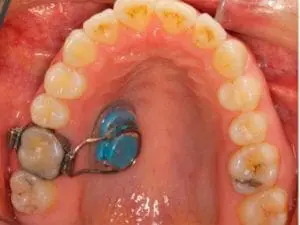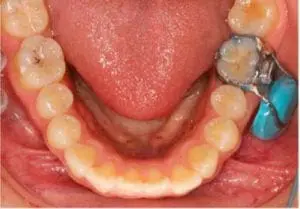How accurate are orthodontic intra oral timers?
Wouldn’t it be great if we could accurately record the time that our patients wear their removable/functional appliances. Recently, new orthodontic intra oral timers have been developed and this new study provides us information on their accuracy.
When I first trained as an orthodontist, one of my colleagues was working on an intra oral timer. Unfortunately, the timers were very bulky and even corroded when he put them into appliances. So he stopped this work.
Now, many years later, a new timer called the Theramon has been introduced onto the market. This timer is sensitive to heat and wear time is measured as the time that the sensor is exposed to temperatures between 33.5-39.0 °C.
The timers have been tested using water baths of different temperatures. Surprisingly, there has been little research done on their accuracy in the mouth. A team from Chesterfield, North of England did this study to measure the accuracy of the Theramon timer.
Catherine Brierley et al
Journal of Orthodontics, 2017 https://doi.org/10.1080/14653125.2017.1365220
They asked these questions;
“Does the Theramon timer record full time wear (24 hours a day) when fixed intra orally”?
“Does the location of the microsensor within the mouth influence the recorded time”?
What did they do?
They did a prospective cohort study. They took a convenience sample of 5 volunteers and placed two intra oral microsensors onto bands and cemented them onto upper and lower molars. One of the sensors was sited in the palate the lower was in the lower buccal sulcus.

 They recorded the wear time for a seven day period. Finally, they compared the actual to the recorded time.
They recorded the wear time for a seven day period. Finally, they compared the actual to the recorded time.
What did they find?
They found that the timers recorded an average daily wear of 23 hours (95% CI 22.6-23.4). This was a mean under recording of 4%. When they looked at the accuracy of the upper (palatal) and lower (buccal sulcus) timers, over a 7 day period, they found that the under recording was 8.7 hours (95% CI 5.0-12.3) for the upper and 5.3 hours (95%CI 1.7-8.8) for the lower.
Finally, they found that the temperature range recorded by the timers was 25.9-43.5 °C. This is important because the Theramon software assumes that the appliance was in the mouth if the recorded temperature was 33.5-39.0 °C. As a result, the Theramon sensor under reported daily wear time.
What did I think?
I thought that this was a clinically relevant, but very small study. It is a nice illustration of how an ex vivo validation does not always translate to the clinical environment. Nevertheless, we need to be cautious when we interpret the results. This is simply because the study sample size is very small. The authors mention this in their discussion and they state that this is a pilot study.
However, I think that their findings are interesting and we should consider whether these results can influence our decision on whether to use the timers. In this respect, I think that we need to look at the effect size. It appears that this was 4% or 1.2 hours a day and you need to consider whether this is clinically significant.
The authors also pointed out that if the manufacturers changed the threshold range then the accuracy could increase to 98%. This is clearly a sensible step to take.
The other important finding was the manufacturers recommend placing the sensors in the palate. Yet, this study showed that the palatal placed sensors were the most inaccurate with an under reporting of 1.2 hours per day. This equals 34 hours over a week period. The authors suggest that this is clinically significant and I am inclined to agree with them.
Finally, these timers have a great potential in helping us motivate our patients or as research tools. I hope that the manufacturers look at this paper and consider if they need to make some changes to their interesting new technology.

Emeritus Professor of Orthodontics, University of Manchester, UK.
My Question is more pragmatic – could this be used w/ clear aligner treatment? Has a “sheath” been designed/fabricated to allow for insertion/removal in clear aligners with patients undergoing high-frequency changes (5-7 day aligner changes)? It seems like that would be particularly useful – especially when evaluating the new Invisalign Mandibular Advancement appliance protocol and comparing to say twin-block etc.
Great work ???? thanks
Apart from wear… to me the take home message is the the temperature stability of the mouth which negates all the ‘wonder claims’ use by those selling thermal archwires. The study confirms mouth does not reach the temperatures to have the claimed effect of iced drinks etc on thermal archwires.
Great study, but it does not consider the effect of cold/warm food and beverages taken inside the oral cavity beeing the reasons for temperatures found between 25.9 and 43,5 °C. Changing the thresholds would not increase accuracy as “fake” measurments would be considered beeing wearing time. When embedded in removeable appliances, accurcy would be 100° – without changing thresholds as usualy removeable appliances are taken out of the oral cavity for eating and drinking !
Congrats! May i learn the price of the timer?